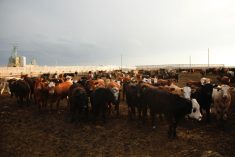Feedlot operators continue to pull in the reins on replacement cattle purchases because another month-end budget for the bank does not look healthy.
Alberta sales barns experienced a soft tone, with sales $4 to $6 below week-ago while eastern Prairie regions received spillover support from U.S. markets. Manitoba markets were notably $3 to $8 higher due to U.S. interest, but keep in mind these regions were non-active earlier in the year. Order buyers were under heavy scrutiny this week as fleshier cattle appeared to be more common. We’re starting to see backgrounded calves come on the market and these cattle can be quite deceiving and punitive discounts of $8-$10 were common. Heavier yearlings were under pressure as a mixed group of steers weighing 875 lbs. averaged $215 in east-central Alberta. Larger-frame red and tan Simmental-cross steers weighing just over 700 lbs. with medium to lower flesh were quoted at $245 landed in southern Alberta.
Read Also

Alberta crop conditions improve: report
Varied precipitation and warm temperatures were generally beneficial for crop development across Alberta during the week ended July 8, according to the latest provincial crop report released July 11.
Prices for lighter calves were very even across the Prairies and feedlots tended to shy away from the market in the non-major feeding areas. Warmer temperatures late in the week made travelling longer distances high-risk for shipping fever. Calves with sweaty thick coats need a fair amount of care. Mixed black steers averaging just over 500 lbs. sold for $298 in central Alberta; larger-frame mixed steer calves in Manitoba sold for $290-$295 with weights from 500 to 530 lbs.
Alberta packers were buying fed cattle in the range of $176-$178 this past week, $20 below breakeven pen closeout levels. Early placed yearlings need about $200, and despite the modest recovery in fed cattle prices, feedlots are risk-averse when buying replacements. Feedlots have experienced one full round of feeding losses; therefore, feeder cattle are coming in line to be profitable with fed cattle prices.
Wholesale prices were lacking demand as the snowstorm in the northeastern U.S. caused restaurant and retail traffic to decline. Seasonally, February is a seasonal low period for beef demand so this adverse weather added to the negative tone. The Canadian dollar has bounced off its lows; after a major drop, the market will correct in price or in time and it appears it is correcting in price. It seems to be limiting the upside on feeder cattle in the short term.
— Jerry Klassen is manager of the Canadian office for Swiss-based grain trader GAP SA Grains and Produits. He is also president and founder of Resilient Capital, which specializes in proprietary commodity futures trading and commodity market analysis. Jerry owns farmland in Manitoba and Saskatchewan but grew up on a mixed farm/feedlot operation in southern Alberta, which keeps him close to the grassroots level of grain and cattle production. Jerry is a graduate of the University of Alberta. He can be reached at 204-504-8339.



















